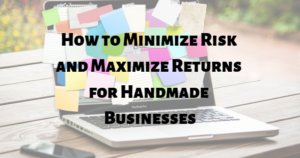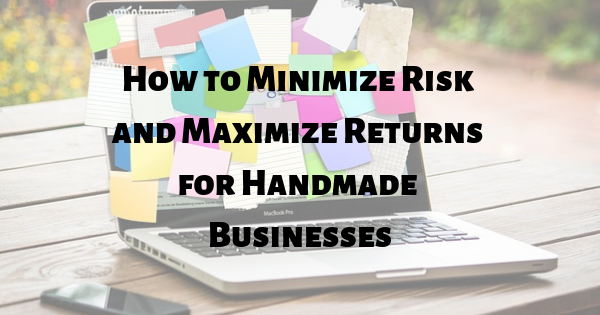Nobody needs to tell you that profit is what keeps a business going, especially in the field of crafting and handmade goods where profits support the creation of the next round of products. Still, entrepreneurs tend to take risks they simply shouldn’t — especially if their business stems from a hobby or passion, like crafting businesses often do.
 While there’s nothing wrong with taking risks, problems often come when they aren’t researched or planned. Unfortunately, they often end up tanking an entire operation.
While there’s nothing wrong with taking risks, problems often come when they aren’t researched or planned. Unfortunately, they often end up tanking an entire operation.
Granted, risk is a necessity for anyone starting a business. The important thing is understanding the difference between a calculated risk and a reckless risk. Western Governors University defines this distinction as such:
- The big difference between just taking a risk and taking a calculated risk is the consideration that goes into it. Risk-takers don’t think about the escape route, the factors that make it risky, and what the situation will be if they fail. Entrepreneurs take calculated risks; they’re willing to “go big or go home,” but they understand the consequences if they fail and have taken into account the likelihood that they’ll succeed.
Art-based projects can be hard to calculate risks for since so much of the return is based on consumer’s wants rather than their needs. Customer demand can be subjective and fluctuate with trends. However, the dream of having your crafts pay for themselves is something most crafters hope for, and navigating risks in a logical way now may allow you to tackle bigger risks more securely later. Likewise, recognizing your threshold for returns now may teach you how to recognize that threshold’s growth later.
Assessing Costs
Everything you do has a net profit or net loss, and you have to consider that. In other words, there is a cost to literally every choice you make as a business owner, and hopefully, a gross profit to cover that loss. These things must be measured together, and you always want to come out on top.
Critical thought is necessary; sometimes you’ll be given opportunities that look really good, but perhaps don’t have the potential result you’re looking for. These opportunities often offer a lot of exposure, which you hope will result in more sales — but it may not be worth it in the long run. For instance, if you’re considering a craft show, you’ll have to consider what the event organizers are paying you (if anything), the time and cost it will take to get there, and what your other options are.
Additionally, you must have the extra materials required for such an event, including the following:
- A booth space
- A table to rent
- A banner or tent for your business
- Shipping, checking, or customs for any products or demonstration material
These, of course, are considerations on top of everything else: the supplies to create your product, the time behind creating them, the time spent at an event that could otherwise be used elsewhere. Especially when it comes to such a feast and famine line of work as selling handmade goods, being particularly aware of your costs and profit margin are imperative. What kind of business can you expect from an event? In some cases, would exposure do you well, or only be a waste of time?
Recovering From Losses
If you’ve taken an opportunity that ended up hurting you, you need to use your head to recover. In these cases, follow the money. Observe business trends around you and figure out how you can use them to your advantage with your own brand. Additionally, utilize the things you’re known for — the things you do best — because customers will come back to that! As Gary Capps wrote in his piece “What You Should Never Do During Low Sales,”
- “Go back to what you do best. Pitch to a new set of people. Reach out to old, happy clients and ask them how you can serve them today. Pitch upsells to the clients you currently have; think of what else they can use that can augment the results of what you already sold them. You shouldn’t avoid exploring new opportunities or taking risks, but you should follow the money when you can to keep your business secure.”
Take big risks later when you can do damage control. Cover your costs now, and work toward being able to take risks more safely. You don’t want to end up going bankrupt because you spent too much without the return. Similarly, you want to have a safety net in case more unexpected loss hits you, and that can’t happen if you’re putting out more than you make.
Lawsuits
Almost nothing can tank you like a lawsuit can. Often, a lawsuit will happen over something you’re not even aware of or didn’t consider preparing for. You have to be on your toes and stay aware of what you’re doing that might get you into legal trouble.
For instance, take copyright law. Especially working in crafting, it’s easy to use copyrighted images with the best of intentions. Familiar aesthetics sell, after all. But if you’re making money off of a copyrighted image, you’re exploiting someone else’s work, which can lead to an incredible amount of trouble. With that in mind, before you use anyone else’s image, make sure you obtain the rights and permission to use it.
Another common risk comes from the materials you use, especially since you’re a crafter. Take an example from a local craft fair you may be a part of:
Imagine your business has a face painting booth set up. Children often find these booths to be particularly entertaining, so you have to make sure you’re using the safest craft paint for kids in these cases. Otherwise, you may face a lawsuit over child safety, or worse, someone could get hurt. This same train of thought applies to other types of crafts — are there small pieces that could fall off something you made, and injure a child or a pet? Are your pieces of work heavy, fragile, or hard to maneuver? Do you want people picking up, examining closely, etc., your work at events?
When it comes to lawsuits and protecting both yourself and your customers, risks are typically pretty easy to identify. It’s just a matter of taking the extra step to ensure nothing could be used against you in a court of law. Being in the know about copyrighted images and the safety of materials you use is worth the extra time spent.
Benefits
You may have financial options you weren’t aware of. Let’s start with business tax write-offs, for instance. Crafters often get confused about this, and if you’re self-employed or use crafting as a side hustle, then there are considerable write-offs you can take advantage of. A lot of this will come down to the materials you use, the cost of which may offset the profit you make. So be sure you’re keeping track of your material costs and holding onto those receipts!
It’s also good to be aware of what loan options you have in case something goes wrong. For instance, if you are a veteran, you have access to USAA personal loans. If you’re disabled, belong to particular minority groups, or are of a certain age, you will have access to different business resources. And of course, the same goes for your geographical location — it’s important to understand what options your local loan companies, banks, and government have for you.
Minimizing risk and maximizing returns as a crafter starts with being aware. Consider your net profit, avoid lawsuits, and use whatever tax write-offs and benefits are available to you, so you can spend more time creating works of art that you are passionate about rather than worrying about money.
Are you a crafter that’s experienced serious profit loss and had to come back from it? We’d love to hear your experience — please share it in the comments below!
- DIY Chicken Wire Jewelry Holder - June 27, 2022
- Jewelry Designer Manager Alternative - December 8, 2019
- 3 Tips To Immediately Boost Your Sales Today - May 12, 2019

